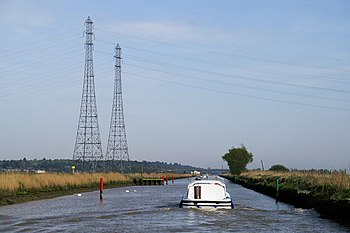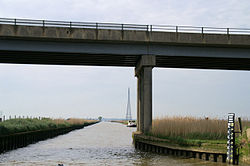Haddiscoe Cut
The Haddiscoe Cut or New Cut is a tidal canal in Norfolk reaching 2½ miles in a straight line between the River Yare and the River Waveney. It is a broad, navigable channel within the Norfolk Broads.
The cut runs between Reedham on the Yare and Haddiscoe on the Waveney.
The cut was made for the purposes of commercial river traffic, conceived as a way to provide a more direct route from Lowestoft to Norwich, and was built as part of a larger scheme which included the linking of the River Waveney to Oulton Broad and to Lake Lothing in Lowestoft. It was opened in 1833, but the new route was not a financial success, and it was sold to a railway developer in 1842. It remained in railway ownership until rail nationalisation in 1948. The New Cut was damaged by floods in 1953 and the next year saw an attempt to close it, which was successfully resisted by local interests, and instead it was repaired. The Cut is now managed by the Environment Agency.
Contents
History
Until the 1820s, barges sailing to Norwich came up the River Yare all the way from Great Yarmouth, which route requires a passage through Breydon Water. Breydon Water, the largest of the Broads, is a wide expanse of shallow water which until the narrow navigation channel was dredged was impassable by larger vessels. Therefore, required cargo arriving at Yarmouth had to be trans-shipped into smaller vessels which could then reach Norwich. There was discontent among the merchants of Norwich at the cost of trans-shipment,[1] and allegations of systematic theft of cargo, which resulted in a court case in 1820, when 18 men were convicted of taking the goods and another of receiving it.[2] Against this background, William Cubitt was asked to investigate possible solutions in 1814.[1]
Cubitt's first plan involved general improvements to the River Yare, and the dredging of a deeper channel along the southern edge of Breydon Water. He estimated that this would cost £35,000, and his plan was published in 1818, but there were immediate objections from the Corporation of Yarmouth, who called on the engineer John Rennie for advice. Rennie concluded that the plan would lead to the silting of Yarmouth harbour and so Cubitt looked at alternatives, and produced a plan to link the Yare to Lowestoft, which would cost over £70,000. Yarmouth objected, as its port would be all but abandoned in favour of Lowestoft, and the first bill in Parliament failed based, but a second bill was passed on 28 May 1827, despite vigorous campaigning against it by Great Yarmouth.[3]
Construction
The new private Act of Parliament created the Norwich and Lowestoft Navigation Company, and authorised them to raise £100,000, with an additional £50,000 if required. The scheme involved dredging of the River Yare from Norwich to Reedham, to make it deeper, construction of the 2½-mile Haddiscoe Cut between Reedham and Haddiscoe on the River Waveney, enlarging of Oulton Dyke, between the Waveney and Oulton Broad, and linking of Oulton Broad to Lake Lothing by a channel which was a quarter of a mile long, and included a sea lock, so that it could be used at all states of the tide. Work began on the Lake Lothing link in 1829.
The work on the Haddiscoe Cut began in 1832.[4] Thomas Townsend worked as contractor on the canal throughout its construction.[5] The original capital was insufficient to finance the construction, and so the extra £50,000 authorised by the Poor Employment Act was borrowed from the Exchequer Bill Loan Commissioners. The cut was finished in 1832, and the dredging of the River Yare completed in 1833. The whole route from Lowestoft to Norwich, which is 32 miles long, was formally opened on 30 September 1833.[6]
Operation
The new undertaking was not a financial success, with income failing to match expenditure. The Company was unable to repay the £50,000 loan, and so in 1842 the Exchequer Bill Loan Commissioners took control of the navigation, and sold it to Sir Samuel Morton Peto, a developer who wanted to build railways along its banks.[7] The line from Reedham to Lowestoft runs parallel to the cut and effectively forms the south-western bank. Although maintained for navigation, the cut was owned by a series of railway companies for the next hundred years.[8]
Control of the Cut passed to the British Transport Commission with the nationalisation of the railways. The cut was damaged by the North Sea flood of 1953, which affected much of the East Coast, and the Transport Commission attempted to close it in 1954.[9] Local opposition was strong, particularly from the yachting community, and control of it passed to the East Suffolk and Norfolk River Board in 1957. Subsequently, the Anglian Water Authority, and in 1995 the Environment Agency, took over this role.[8]
In 1993 failure of the piling resulted in part of the railway embankment being washed away.[8] More recently, flood prevention measures have resulted in reconstruction of the river defences and walls, and this work was completed in 2006.[10]
Miscellany
The Haddiscoe Cut features in Arthur Ransome's Coot Club (named there "The New Cut"). The barge Welcome and later the Teasel pay the toll to open the road bridge on the New Cut by dropping two shillings into a proffered fishing net.
Outside links
References
- ↑ 1.0 1.1 Boyes & Russell 1977, p. 113
- ↑ Boyes & Russell 1977, p. 116
- ↑ Boyes & Russell 1977, pp. 115–116
- ↑ Wren 1976, p. 108
- ↑ Skempton 2002, p. 714
- ↑ Boyes & Russell 1977, pp. 117–118
- ↑ Boyes & Russell 1977, pp. 119–120
- ↑ 8.0 8.1 8.2 Broadland Flood Alleviation Project - Haddiscoe Cut Consultation Document
- ↑ Boyes & Russell 1977, p. 120
- ↑ Broadland Flood Alleviation Project - Haddiscoe Island Compartment
Books
- Boyes, John; Russell, Ronald (1977). The Canals of Eastern England. David and Charles. ISBN 978-0-7153-7415-3.
- Skempton, A. W. (2002). A Biographical Dictionary of Civil Engineers in Great Britain and Ireland - Vol 1: 1500 to 1830. Thomas Telford. ISBN 0-7277-2939-X.
- Wren, Wilfrid John (1976). Ports of the Eastern Counties. Terence Dalton Limited. ISBN 978-0-900963-70-4.

